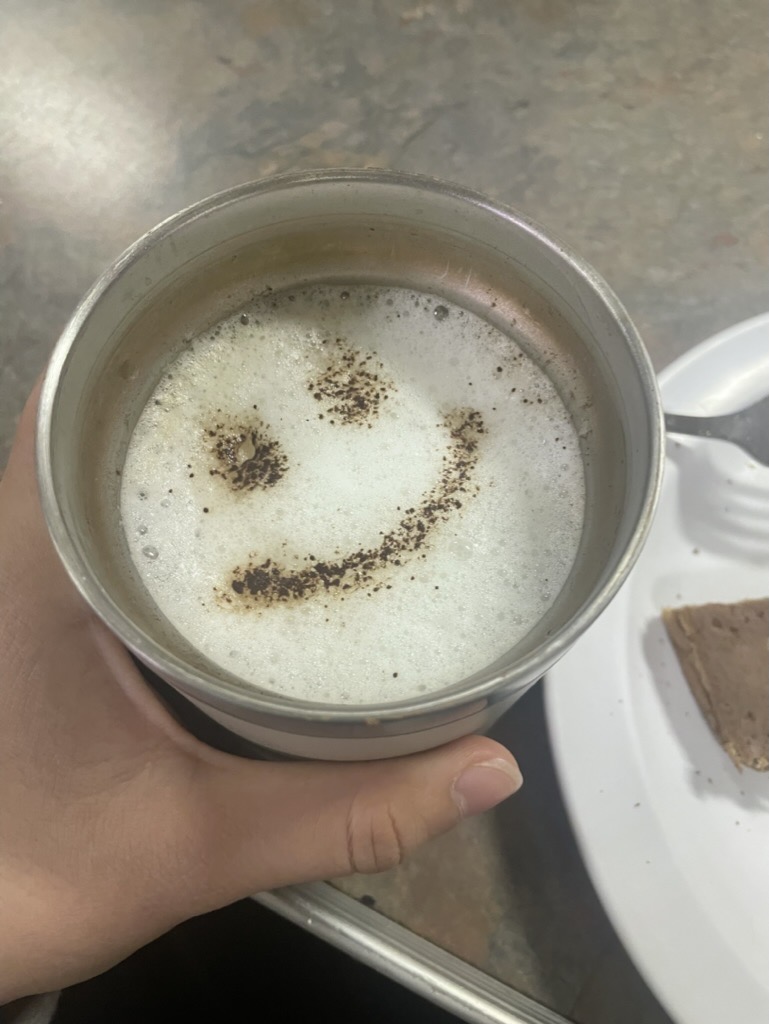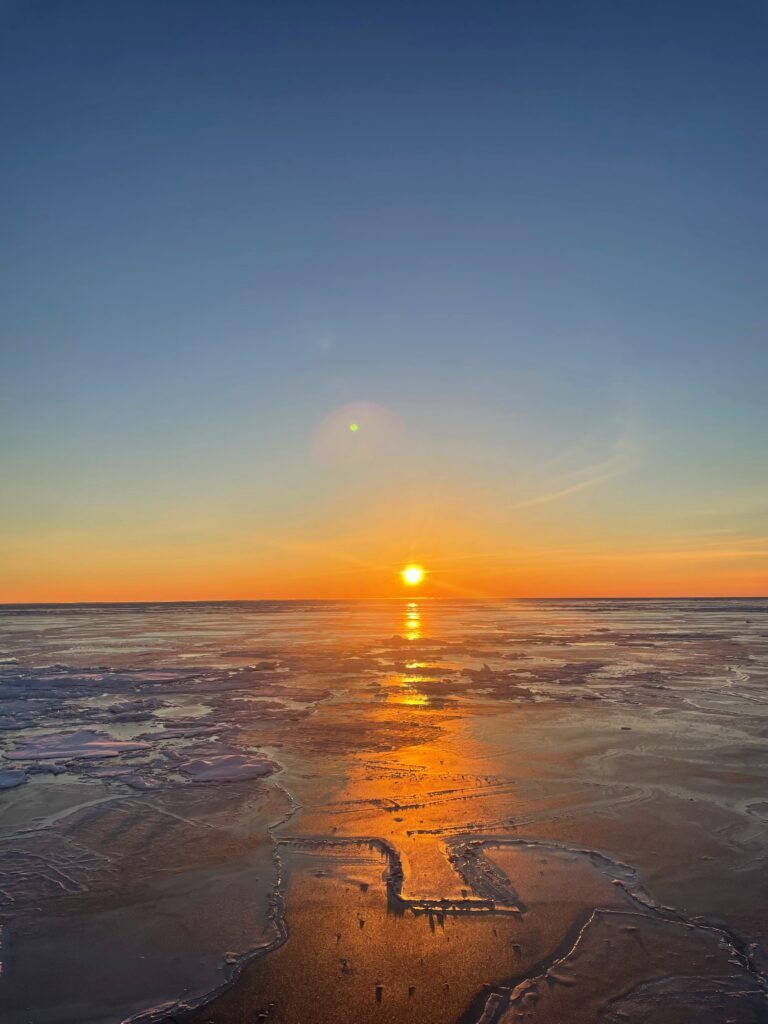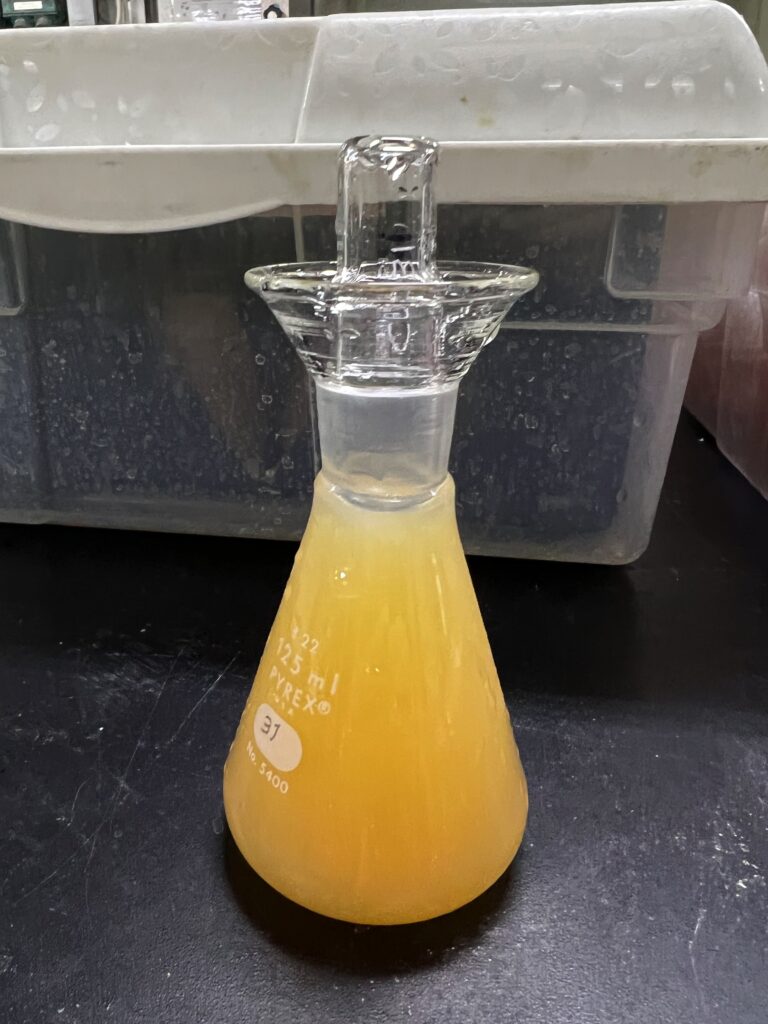Did you wonder how life on a research cruise looks like?
I’m not a morning person and I’ve never been, but when it comes to science, I crawl out of my bed, change my clothes, wash my face, and head out to pick up coffee. As I mentioned before, there is a coffee shop in the ship that opens at 7:45 am and is only open for 20 minutes. With my brain still asleep I join the line that already comes out of the room, where people from the night shifts (midnight to noon) and the early birds (like me) take a moment to chat. Mason, a STARC team member, is as joyful as always: “Good morning, everyone! The sun is out, what a beautiful morning!”, raising the mood of everyone in the room. I get a “Dutch,” which is two shots of espresso and foam, and the girls from the Healy crew that work in the coffee shop in their free time draw a smile face in my foam. I’m ready to head out to the main lab.


After passing through a couple of watertight doors, I reach the main lab and then go one stair up, where the aft room is. In the room I see Laurie Juranek, my advisor, already drinking her coffee and monitoring the CTD as it goes down through the water column. There are other scientists, the physical oceanographers, controlling and commanding the CTD, working closely with the person that controls the winch. The science team looks at the screen with the CTD profiles, and watches for the altimeter, the multibeam, and the echosounder to come up with a “target depth,” the bottom depth close to the seafloor.
I sit down in the chair that looks out the window. I can see the fantail, the back side of the ship, and the ice that we run over when moving north. We can still see the sunrise, filling the sky with pretty colors. I drink my coffee contemplating the frozen sea. A week ago, we could see big swells, but now the ice is starting to freeze, changing the scenery of the ocean. The ship is still, unmoved by waves, which is a relief for the drivers – they can lay down against a ridge to get support from the ice. If we were further south, they would have to fight against the wind and waves to try to keep the ship still. In fact, two weeks ago we lost our CTD because of conditions like this. The $200,000 instrument’s cable snapped; I could see the sparks it created in the air as it disappeared in the ocean. Now everyone is being extra cautious because we cannot afford to lose another one.
After a couple of weeks, we have set up a nice routine for science onboard. The chief scientist decided we needed to come up with a plan so we could reach the North Pole in time, and she needed to consider all different groups and their science. Since most of the basin has depths greater than 2000 meters, we could not conduct full CTD casts every day: A full cast at 3800 meters could take approximately four hours!
When we do conduct CTD casts, the fun begins once the instrument has returned to the surface and is pulled onboard. At that point, 24 bottles, each containing 12 liters of Arctic water, sit on the deck waiting for everyone to get their share. The dissolved oxygen team goes first since we need to limit environmental contamination in our water. This team is composed of OSU people: Laurie, Genevieve, and me. Laurie has trained us to properly sample from the water, always watching out for bubbles — we don’t want bubbles! We are now independent in our sampling process and our leader watches us proudly from the door. The first thing we need to do is to take the draw temperature, which is the temperature of the water when we first open the Niskin bottle. This is an important step for density calculations at the time the sample is taken. I yell from the side of the room, “-0.1,” and Genevieve writes down the temperature and then hands me the flask I will use for sampling. The water is so cold we had to start using double gloves to protect us from freezing temperatures. I rinse the flask and start filling it up with water, watching out for any bubbles, then I hand her the flask so she can “pickle” the water with chemicals that will “fix” the oxygen concentrations of the sample – keep it exactly the same for later analysis. She gives the flask a good shake to mix all the chemicals. Once we finish, we fill the neck of the flask with deionized water to prevent any oxygen from entering the sample. After 30 minutes and a second shake of the flasks, we are ready to leave them in the dark so they can come up to room temperature.

Always after us, the CO2 people have their turn, then the methane group, then the biologists. At the end, everyone has taken some water to do their analysis. While the CTD team is sampling there is other science happening on the other side of the ship. Plankton nets are deployed to vertically sample from the water column. The biologists deploy a plankton recorder, which is a camera that takes pictures of the microorganisms in the water column. We pump and filter water to collect particulate organic carbon in the water column – the pumps need to be under water for four hours! Lastly comes the benthic (bottom) sampling, which uses different coring instruments to get samples of sediment from the ocean floor along with the organisms in it. At this point it is already midnight, and the cores will take hours to process, extending to the early morning of the next day. We call this a “long station.”
The next day is a short station, during which we perform two small CTD casts at 1000 meters and deploy plankton nets and video recorders. We don’t sample for each water depth as we did the day before. While the benthic people are resting from the long night of coring, the dissolved oxygen team is already preparing to analyze the samples that were taken the day before.
It’s time for Winkler titrations! We use a series of known chemical and mathematical relationships – known as stoichiometry — to calculate oxygen concentrations in the water samples. I’m glad stoichiometry was always my favorite topic in chemistry because now I am relying on it to collect my data! After six hours of analysis, we are ready to leave the lab and prepare for the long station that comes the next day.
My work as I relax in the afternoon is to log all the data taken during the day and make graphs to make sure everything looks fine. I live for science every day as everyone in the ship does, but we always find time to relax. We get together in the Science Conference Room to watch movies together, where I eat popcorn and analyze some data with my computer on my lap. I take breaks from the screen to work on a puzzle, and on Sundays we have ice cream!

When days are rough and long, Genevieve and I know where to go: the bridge, one of the highest points of the ship where the captain and his mates are driving. All the big windows provide the best view we can have in the ship while also keeping ourselves warm from the cold. We see the sun going down over the horizon and we try to catch the green flash, a polar bear, or other mammals. The most stunning view is the frozen ocean breaking from the top of the ship. Pushing the pieces of ice to the side, we see the cracks extending northwards, opening our way to the North Pole.
These pictures were taken during the NSF-funded U.S. Synoptic Arctic Survey (SAS) expedition Healy 2202.